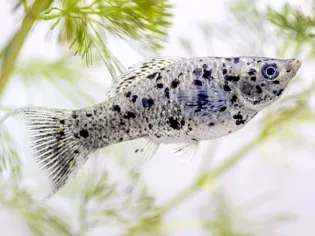Molly Fish Species Profile
Updated on 04/26/24

Discover the Enchanting World of Molly Fish: A Comprehensive Species Profile
Introduction
Embark on an aquatic adventure as we delve into the fascinating world of molly fish, a vibrant and diverse group of livebearers renowned for their hardiness, adaptability, and captivating colors. With their ease of care and eye-catching appearance, molly fish make excellent additions to both beginner and experienced aquarists' tanks. In this comprehensive species profile, we'll explore the history, characteristics, care requirements, and breeding habits of these captivating fish.
Historical Origins
The genus Poecilia, to which molly fish belong, originated in the waters of Central America. The first recorded species, Poecilia sphenops, was described in 1797 by Marcus Elieser Bloch. Over the years, several other species have been identified, each with its own unique characteristics and distribution.
Characteristics
Molly fish come in a wide range of sizes, shapes, and colors. They are typically characterized by their rounded bodies, flattened heads, and prominent lower lips. Females are generally larger than males, with a maximum length of 5 inches, while males typically reach a length of 3 inches.
The most striking feature of molly fish is their vibrant coloration. They exhibit a mesmerizing array of hues, including black, white, blue, green, orange, red, yellow, and gold. Some species even display intricate patterns and iridescent markings.
Care Requirements
Molly fish are relatively easy to care for, making them ideal for both novice and experienced aquarists. They thrive in well-maintained aquariums with the following conditions:
* Water Temperature: 75-82°F (24-28°C)
* pH: 7.0-8.5
* Water Hardness: Soft to moderately hard
* Tank Size: A 10-gallon tank is sufficient for a small group of molly fish.
* Filtration: A reliable filter is essential to maintain water quality and remove waste.
* Aeration: Molly fish require well-oxygenated water, so ensure adequate aeration.
Feeding
Molly fish are omnivorous and will readily accept a variety of foods, including:
* Live foods: Brine shrimp, daphnia, mosquito larvae
* Frozen foods: Mysis shrimp, brine shrimp
* Flake food: High-quality flake food formulated for tropical fish
* Prepared foods: Pellets or tablets designed for bottom-feeding fish
Breeding Habits
Molly fish are prolific breeders, and females can give birth to multiple broods throughout the year. Pregnancy typically lasts for 30-45 days, after which the female releases 20-100 fry. The fry are fully developed and can swim and feed independently.
To encourage breeding, provide a spacious tank with plenty of hiding places and live plants. Maintain optimal water conditions and offer a varied diet rich in protein.
Varieties of Molly Fish
There are numerous varieties of molly fish available, each with its unique appearance and characteristics. Some of the most popular include:
* Black Molly: A classic variety with a jet-black body and iridescent scales.
* Dalmatian Molly: Known for its distinctive black spots on a white or yellow body.
* Fancy Molly: Exhibited long, flowing fins that enhance their graceful appearance.
* Gold Dust Molly: Characterized by a shimmering golden hue and black spots.
* Sailfin Molly: Features an elongated dorsal fin that resembles a sail.
* Lyretail Molly: Possesses a lyre-shaped tail fin, giving it an elegant appearance.
Benefits of Keeping Molly Fish
In addition to their beauty and ease of care, molly fish offer several benefits to aquarists:
* Hardy and adaptable: They can withstand a wide range of water conditions and are not prone to disease.
* Active and entertaining: They are lively and interactive fish that can provide endless entertainment.
* Good community fish: They generally coexist peacefully with other non-aggressive species.
* Beneficial for plants: They feed on algae, helping to keep your aquarium clean.
* Educational: Observing and caring for molly fish can be a fascinating educational experience.
Conclusion
Molly fish are a captivating species that add color, vitality, and entertainment to any aquarium. Their hardiness, adaptability, and ease of breeding make them ideal for both novice and experienced aquarists. By providing proper care and understanding their breeding habits, you can enjoy the beauty and benefits of these charming fish for years to come.
Explore More Pets

Freshwater Aquarium Filters
How to Deal With Cloudy Aquarium Water

Saltwater Aquarium Filters
How Do You Remove Chloramines From Tap Water?

Freshwater Aquariums & Habitat
Can I Keep My Koi Fish Inside?

Saltwater Aquariums & Habitat
14 Best Floating Plants for Your Aquarium

Freshwater Fish Health
How to Treat Ich on Freshwater Fish

Saltwater Fish Health
Fin Rot in Aquarium Fish

Freshwater Aquarium Filters
How to Do Aquarium Water Changes

Saltwater Fish Health
How Do Fish Get Parasites?